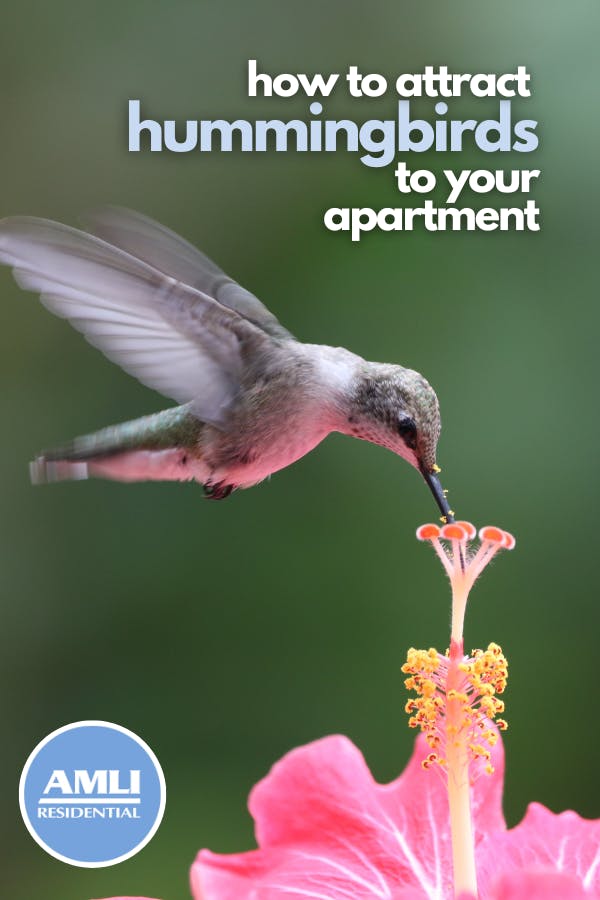Spotting a hummingbird is always a treat, and having one frequent your balcony is even better!
If you live in a climate zone that favors hummingbird populations, then you can attract them right to your window by creating a small garden with the right kinds of flowers, food and water that they enjoy!
Whether you have space for a patio garden, a few hanging pots or just one feeder, here are some ways you can successfully attract hummingbirds to your apartment’s balcony or patio!
How to get hummingbirds to your patio
Grow native flower species
What better way to attract local hummingbirds than by using local flower species?
Part of creating a garden attractive to hummingbirds is planting a variety of flowers of all shapes, sizes and colors, as well as some native flowers that will grow well in your climate zone. Plus, having familiar flowers on your balcony will signal to hummingbirds that there is food that they recognize there, which will make your garden all the more hummingbird friendly!
Use sugar-water in the feeders
If you can’t get a garden full of flowers, then a hummingbird feeder filled with a sugar-water solution is a great alternative!
You can make a simple “nectar” at home by dissolving one cup of sugar in four cups of warm water. Stir until the sugar is dissolved, then allow to cool before filling the feeders with the nectar. Make sure to have something red nearby to attract the birds to the nectar, such as a red feeder, a red ribbon, a red sign or red flowers!
Keep the feeders clean
It’s a good rule of thumb to keep your bird feeders clean and tidy, no matter the bird. Old seeds, bird poop, dead bugs and rotting seeds can introduce mold into whatever feed you have, so make a habit of cleaning your bird feeders every week.
It’s even more important to keep your hummingbird feeders clean and tidy, especially if you’re using a sugar water solution. The sugar water might start to ferment if the feeder is in direct sunlight for too long, and if the feeder itself is dirty and sticky then hummingbirds will not want to eat and rest there.
Be sure to use gentle cleaning solutions to clean the feeders, too, to avoid introducing harmful chemicals into the birds’ food. A bit of warm water and vinegar ought to do the trick!
Add some safe perches to your balcony
Hummingbirds flap their wings at a rate anywhere between 720 to 5,400 beats per minute, and as such have to eat every 10 to 15 minutes to keep up their energy! Hovering uses up the most energy, so hovering around flowers and food takes quite the toll on these tiny birds. Basically, a hummingbird’s life is spent in periods of intense energy output and intense resting to recover.
Installing small perches around your hummingbird garden gives these little creatures a safe place to rest and keep an eye out for insects nearby. These perches can be as simple as a stick shoved into a plant pot or a twig lodged into a fence post. Hummingbirds prefer natural-looking perches to metal or plastic ones, as they are more familiar and less threatening.
Install a birdbath with moving water
Hummingbirds love playing in the water. Moving water, to be specific.
These little birds get most of their water from the nectar that they drink, but they still frequent water sources to wash off any sticky nectar from their feathers. They can make do with mist or dripping water that they will rub in with nearby leaves, rocks or sticks.
There are plenty of small, solar powered bird baths out there with small bubblers, drippers or gentle misters that will make your garden extremely attractive to hummingbirds. Don’t get anything too deep or too big, and keep the water source clean and far from any pets!
Red flowers galore!
There’s science behind hummingbirds’ love of bright red flowers!
The cones in a hummingbird’s retinas are pigmented with yellows and reds, giving them a higher sensitivity to colors that contain more yellow and red and a lower sensitivity to blues and greens, This helps them spot flowers from far away and to filter out any colors that they can’t get food from.
All that to say that you’ll have much more luck attracting hummingbirds by planting flowers that have reds, yellows and oranges in them than flowers that are white, purple or blue.
Use a variety of feeders
Male hummingbirds are very territorial and will attack other hummingbirds viciously over a food source. If you get two or more feeders and separate them a little, then there will be less competition between visiting hummingbirds.
Avoid pesticides
Pesticides keep insects and other natural critters far from your lovely garden, and while this may make caring for your plants easier, using pesticides will end up keeping any birds you’re trying to attract far away.
Hummingbirds have a diet that consists of both nectar and small insects, like spiders, mosquitoes, aphids and other small creepy crawlies. Using pesticides will kill your bug populations which, as a result will make your garden less attractive to hummingbirds looking for food. Those pesticides also add harmful chemicals to the environment and can be toxic for birds, especially small birds like hummingbirds.
By following these tips, you’re certain to attract at least a few gorgeous hummingbirds to your apartment balcony!
Good luck!
Pin it!

Featured photo courtesy Pixabay/fprose


 View All Posts by Colleen Ford
View All Posts by Colleen Ford